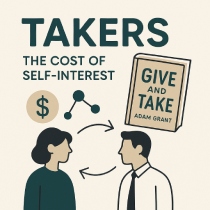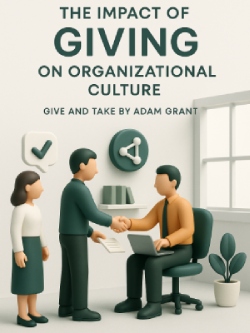In Give and Take: A Revolutionary Approach to Success, Adam Grant flips conventional wisdom on its head, suggesting that success isn’t solely about who you know or how hard you work, but about how you interact with others. He categorizes people into three distinct groups, givers, takers, and matchers, and dives into how each affects both personal and professional success. This book is more than just a guide to improving one’s networking skills; it’s a study on human behavior and its profound effects on careers, relationships, and overall success
The Concept of Giving and Taking
It is basically about three types of people existing in the world: givers, takers, and matchers. Givers help others-for example, with their time, knowledge, or resources-less for an expectation of something in return. Takers are those who always want to get as much as possible from other people and provide the least in return. Matchers are sort of in the middle; they believe in an equal sort of give and take, following a “scratch my back, I’ll scratch yours” type of principle.
According to Grant, in contrast to the theory that givers are the ones who finish last, they are actually the most successful in the long run. While takers steal their way to the top, givers build genuine relationships that bring great fulfillment and success to them. Matchers, generally speaking, tend to be transactional and can make moderate success; however, they don’t quite have the long-term benefits givers have.
The Power of Generosity
Intertwined into the central thread of Give and Take is the notion that generosity in the workplace can lead to success and a flourish in the lives of individuals. In giving examples and conveying stories, Grant said that whenever granting, the giver may present an opinion, help a colleague with her project, or simply listen to someone who is venting. In those cases, they create a network of goodwill that may pay back those givers when they least expect it. Unlike bartering in return for favors or benefits, it is about generating a ripple effect that eventually leads to opportunity, collaboration, and mutual support.
In one such extreme scenario, the reverse is dramatized with stories of individuals who simply choose to give. Grant then explains that those who go out of their way to help others with no expectation of anything in return are usually the same people who attain extraordinary success in their own careers. The message is unmistakable: by giving, you establish your name, your community, and your support, and these will carry you forth.
Takers – The Cost of Self-Interest

While givers are positioned as the ultimate success story, Grant also explores the other side of the less-favorable story of takers. Such individuals are self-interested, often at the expense of others. They generally make forward progress by any means available: taking credit for someone else’s work, or misusing a relationship for their own gain.
Grant maintains that even though takers may have some short-term success, this will eventually come to an end because they lack authenticity and generosity. Hence, with time, they lose their reputation and find it difficult to establish meaningful, solid relationships that sustain full-fledged success. Often, when takers come to a low point in life, they will end up all by themselves since they are likely to have wisely exhausted all support networks that givers have created.
Matchers – The Middle Ground

Matchers are the most common type of persons in any work environment. They balance their giving with a sense of fairness: they help others only if there is a reciprocal benefit. Matchers, being neither somewhat selfish like takers nor excessively giving like givers, Grant says, may not be choosing the most optimal path in the long run.
In the immediate short term, they tend to be winners because they are pragmatic and know how to manipulate the system. But the building of strong, sustainable, and genuine relationship-based human connections is something givers excel at and matchers fall behind. The matchers certainly succeed in competitive environments, but their rewards do not match those of givers who build trust and cooperation.
How to Build the Giving Mindset
While the book places a heavy emphasis on the benefits of giving, Grant is very blunt about the problems involved: givers are prone to burn out and be exploited. To prosper, givers must set boundaries and take care of themselves so that they are not taken advantage of. A pivotal realization found in Give and Take is that being generous does not mean being a doormat.
Grant then outlines ways in which one may foster a giving attitude with balance. One is called “strategic giving.” Instead of randomly giving away their support, givers consider the high-impact opportunities that will maximize the impact of their gifts. By giving in a way that aligns with their values and what truly matters to them, givers can be assured that their giving is not only good for others but also good for themselves.
On the Importance of Networks and Reciprocity
A key principle in Give and Take is that the key to success characteristically is not really what you know, but rather whom you know and how you treat them. The book emphasizes networks on top of the principle of reciprocity in relation to success. Givers forge networks of trust, collaboration, and mutual assistance, whereas takers and matchers usually have only more transactional relationships between them.
Grant says that give-prosperance research shows that givers usually succeed because of the so-called “weak ties” they share with a wide array of people. Weak ties are looser relationships than close friendships, but they provide a better pool of opportunities. Givers tend to assist others more, and those others feel equally obliged to assist givers. Thus, a reinforcing loop of generosity and support ensues.
Real-Life Examples and Case Studies
Throughout the book Give and Take, Grant uses case studies based on reality to give life to the concepts of giving, taking, and matching. From CEOs and entrepreneurs to underpaid workers, Grant shares examples that are as wide-ranging as these behaviors are diverse in expression across industries. One of the memorable stories is that of a guy named Joe, who had done well in his entire career for others while never expecting anything in return; then, lo and behold, years down the road, he found this major opportunity just cross his path.
Another powerful example concerns an academic who had mentored hundreds of students with no expectation in return. The network of mentees-now scattered across the globe-provided an avenue for a groundbreaking collaboration that changed the trajectory of his career. These stories underscore the fact that giving is not always punished by instant gratification, but eventual success is assured.
The Impact of Giving on Organizational Culture

Besides studying individual success, Grant also examines how the principles of giving, taking, and matching apply to organizational culture. The firm’s very outlook on mentorship, collaboration, and team spirit has an enormous bearing on its performance and morale.
Givers, especially those at the helm, want the learning, mentorship, and collaboration to come first. Among other things, this brings about a culture of trust, in which workers are equally willing to help each other stand above innovation, problem-solving, and performance. Conversely, in taker-run workplaces, competition prevails along with mistrust and fear that stifle creativity and trample on collective success.
Grant’s work also suggests that when an organization promotes giving, the employees come to feel connected to a larger purpose. Givers, rather than being motivated through personal gain, are motivated out of helping others and making a positive impact. Thus employee satisfaction may increase along with employee retention, since people feel that they are doing meaningful work rather than just going in and out for their wages.
Giving culture in an organization is not just another nice-to-do-it; it is actually building a sustainable and mutually supportive ecosystem for everyone to flourish. Leaders who model generosity in action, who invest in growing and developing their team, and encourage others to do the same, shift the culture from one of scarcity to one of abundance. This cultural movement will ultimately change the fortunes of any organization and ensure its longevity.
Success Is About What You Give, Not Just What You Take
Give and Take is a thought-provoking, research-backed exploration of the dynamics of success. Grant challenges the conventional notion that success is achieved solely through self-promotion and individual effort. Instead, he emphasizes that true success lies in how we interact with others, whether we’re giving, taking, or matching. For entrepreneurs, professionals, and leaders alike, this book offers valuable insights on how generosity can be the key to both personal and professional success. At Startup Mentorship Hub, we recognize how Grant’s ideas resonate strongly with the mentorship journey, where giving often leads to the greatest growth.